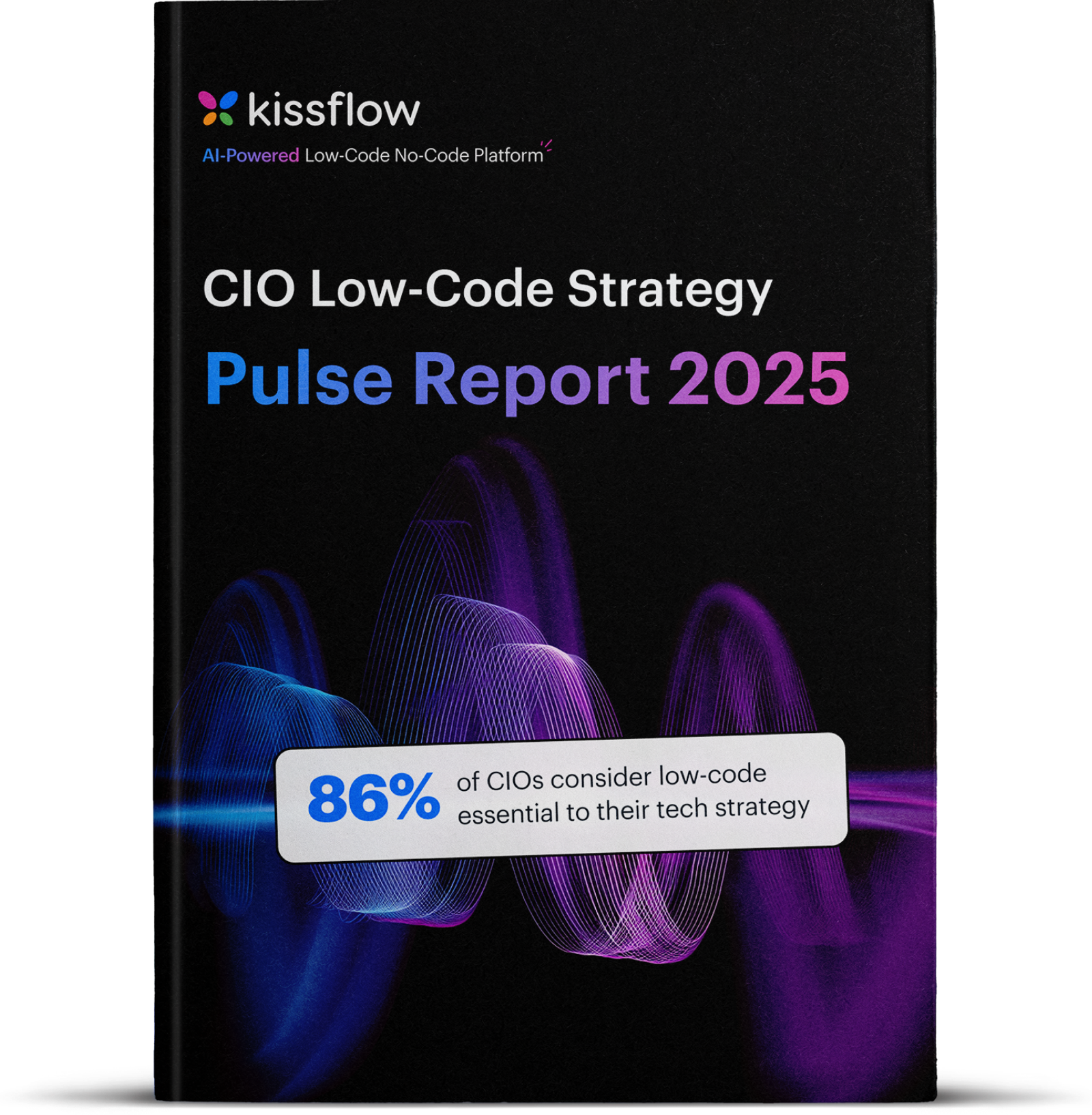
Business process automation (BPA) is the use of technology to mechanize manual, recurring tasks in business operations. It leverages robust business automation tools like Robotic Process Automation (RPA), Intelligent Document Processing (IDP), workflow orchestration, Artificial Intelligence, integrated systems, and business rules to streamline operations.
By 2025, 80 percent of organizations will adopt intelligent automation. This makes automating workflows a necessary step for CIOs looking to embrace digital transformation and future-proof their enterprises fully. However, over 90 percent of automation projects fail due to technical issues, high implementation costs, lack of strategy, and resistance to change.

Understanding business process automation and how it can be achieved successfully is crucial for organizations looking to boost efficiency, improve productivity, and implement new business models.
What is Business Process Automation (BPA)?
Business automation, also known as business process automation, leverages technology to automate operations and functions within a corporation. Using a business process automation tool is essential for successfully transitioning from manual to automated workflows. Understanding the key business process automation steps can yield significant efficiency improvements by helping organizations convert traditionally manual procedures into automated processes throughout the entire entity.
The main objectives of BPA tools are to:
- Enhance operational efficiency
- Minimize errors
- Standardize processes
- Liberate employees to concentrate on more strategic, value-added activities
By automating routine tasks, organizations can significantly increase productivity and reduce costs, leading to improved business performance.
Learn more: Low code process automation software
How BPA, RPA, and BPM are Interrelate
Business Process Automation (BPA), Robotic Process Automation (RPA), and Business Process Management (BPM) all contribute to improving operational efficiency but serve different purposes:
BPA vs. RPA
While both BPA and RPA aim to automate business operations, their scope differs significantly:
- BPA automates entire workflows, connecting multiple systems and ensuring process continuity across departments.
- RPA focuses on task-level automation, handling repetitive activities such as data entry, invoice processing, and system integrations without altering the underlying process.
BPA provides broader transformation, whereas RPA acts as a tactical solution for specific tasks. Employees involved in high-impact RPA use cases see efficiency gains of 200 hours per year (approximately 10 percent), while employees involved in medium-impact use cases see time savings of 20 hours per year.
BPA vs. BPM
BPA and BPM share a common goal of improving business efficiency, but their approaches differ:
- BPA focuses on automating and executing business processes using technology.
- BPM is a strategic discipline that governs and continuously improves processes, ensuring they align with business objectives.
BPA is the execution layer that brings BPM strategies to life, enabling automation while maintaining compliance and efficiency.

Types of Business Process Automation
- Robotic Process Automation (RPA): Uses bots to complete repetitive tasks like data entry, document processing, and transaction handling.
- Workflow Automation: Organizes tasks, approvals, and data movement across teams to ensure a smooth and structured process.
- Digital Process Automation (DPA): Focuses on digitizing and automating end-to-end processes to improve efficiency and eliminate manual steps.
- Intelligent Process Automation (IPA): Uses AI and machine learning to analyze data, make decisions, and automate complex workflows.
- Enterprise Process Automation (EPA): Connects different business functions and systems to streamline company-wide processes and ensure data consistency.
Learn more: Hyperautomation Guide
Business Process Automation Examples
1. Employee Onboarding
Although hiring employees may seem straightforward, it involves multiple tasks: filling out employee information forms, setting up induction sessions, arranging training sessions, setting up bank accounts, collecting relevant documents, and assigning mentors.
Without automation, the entire process can become chaotic and result in:
- Endless paperwork
- Missing out on some tasks
- Employee dissatisfaction
- Low productivity
Applying business process automation to employee onboarding ensures smooth transitions from one task to the next, keeping relevant employees in the loop and providing visibility into the status of the process.
2. Purchase Orders
Purchase order requests are recurring processes in most organizations. The requesting team fills out a form and sends it to the purchasing team. The approving authority examines the request and either approves or rejects it based on information adequacy and budgetary constraints.
Without automation, the following issues could arise:
- Delayed PO approval
- Impacted productivity
- Incomplete records
- Errors in the PO
- Errors while taking delivery of supplies
A business process automation platform can help improve accountability, transparency, and enable accurate data recording, which can be accessed by relevant stakeholders when necessary.
Learn more: Process automation solutions
Why Automate Business Processes?

1. Stepping Stone to Digital Transformation
Digital transformation can seem overwhelming to organizations not on that path. Business process automation can be a stepping stone to adopting a culture of continuous transformation. You can start with a few processes clearly in need of course correction and gradually work your way up.
2. Get More Clarity
Automating business processes demands clarity about the process at the design stage. Process mapping can provide clarity to all employees and serve as a training resource. The insights gained from analyzing an automated process can clearly show the gap between your business process as it is and as it should ideally be.
3. Streamline Processes
One of the great outcomes of a process automation system is streamlined processes. Clear accountability, customizable notifications, valuable insights, catalog automation, and faster turnaround times make it easier to eliminate wasteful activities and focus on enhancing tasks that add value.
4. Get Compliance Records
With business process automation, every detail of a business process is recorded. This information can be presented to demonstrate compliance during audits.
5. Standardize Operations
When you automate a business process, you can expect consistent outcomes every time. Standardization helps position your organization as reliable, which can increase your customer base.
6. Increase Customer Satisfaction
Customer satisfaction is a key differentiator in any industry. Focusing on process and operational excellence helps you exceed customer expectations. When you consistently meet promised standards, customers are more likely to develop a preference for your company.
Features of Business Process Automation
Workflow Management: Streamlines and organizes tasks for efficient execution.
Task Scheduling: Enables automated scheduling of tasks and processes based on predefined rules.
Process Monitoring: Tracks progress and provides real-time insights into ongoing processes.
Integration: Seamlessly connects with existing software and tools to unify data and processes.
Reporting and Analytics: Offers data-driven insights to support decision-making and process optimization.
User Roles and Permissions: Ensures secure access control and task delegation within the system.
Alerts and Notifications: Sends timely updates to stakeholders, keeping them informed of progress or issues.
Error Handling: Detects and resolves issues to maintain smooth process execution.
Customizable Templates: Provides pre-built templates that can be adapted to specific business needs.
Version Control: Manages and tracks changes made to processes, ensuring consistency and auditability.
Best Practices for Business Process Automation
As automation evolves, employees must develop new skills to adapt to shifting roles and remain competitive. Automation should be implemented thoughtfully to minimize job displacement and ensure fair access to technology.
Here are some pointers on how you can make automation a success:
- Start with a clear understanding of the tasks, responsibilities, and execution timing.
- Ensure clearly defined goals when automating a business process to save time in course correction.
- Measure results with a phased approach, as results don't materialize overnight.
- Invest adequate time in training employees and factor in an adjustment period.
- Use readymade solutions where available.
BPM Adoption and Automation Trends (2026)
|
Trend/Metric |
Recent Data & Insights |
|
Adoption Rate (General BPM) |
74 percent of businesses have shown increased interest in adopting BPM. |
|
BPM Tool Usage |
70 percent of businesses use at least one BPM application; 63 percent use two or more tools. |
|
Process Tracking |
Only 4 percent of companies track their processes in detail. |
|
Process Automation Adoption |
66 percent of businesses have automated at least one process as of 2024. |
|
Projected Automation Adoption (2029) |
Expected to grow to 85 percent of businesses automating at least one process by 2029. |
|
Low-Code/No-Code Automation Implementation |
24 percent of companies have implemented low-code platforms; 29 percent plan to adopt soon. |
|
AI & Automation Integration |
AI and RPA are increasingly integrated into BPM solutions, driving process efficiency and transformation. |
|
Cloud-Based BPM |
Over 64 percent of BPM deployments are cloud-based, enabling easier automation and scalability. |
|
Automation Segment Growth |
Automation within BPM is projected to grow at a CAGR of 21.6 percent from 2025 to 2034. |
|
Drivers of Adoption |
Key drivers include the need for operational excellence, agility, cost reduction, and digital transformation. |
How Kissflow fits into your BPA strategy
Kissflow addresses core challenges in enterprise automation:
- IT backlog reduction: Apps that take 5 months can be built in 1 month on Kissflow
- Cost savings: Save $40,000 per app—up to $400,000 for 10 apps
- Productivity boost: 30 citizen developers can generate $3.5 million in annual value in a 1000-person company
Why CIOs and CDOs choose Kissflow:
- Supports both CADP and LCAP needs
- No-code for process owners and low-code for IT
- Unified work platform: Process, app, case, and task management in one place
- Pre-built connectors: Google Workspace, Microsoft, Slack, Salesforce, and more
- Governance-ready: Patented rules engine and data control
- Cloud-native: Scales with usage and adoption
Kissflow is ideal for:
- Line-of-business (LOB) apps across procurement, HR, finance, and operations
- Middle office operations often ignored by ERP systems
- Custom micro-apps that don’t require full-blown development
How our customers use BPA
Case Study: Lumen Automotive Transforms Manufacturing Processes
Lumen, an Australian automotive manufacturer, revolutionized their manual processes with Kissflow's intuitive platform:
- Automated 10+ critical processes, including Premium Freight Authority, Purchase Orders, and more
- Successfully connected data across processes without duplication
- Created custom management reports that leadership loved
- Achieved measurable improvements in cost savings, tracking efficiency, and SLA adherence
- Reduced delays and missing data across operations
"Kissflow is one of our main systems. It lets everyone have any form request that goes through multiple departments for actions."
— Madhuri Balimane, CI/LEAN Lead, Lumen
Read the full Lumen success story →
Case Study: Servitron Eliminates Paper-Based Approval Bottlenecks
Servitron, Mexico's leading radio communications provider, transformed its manual approval system:
- Empowered non-technical users to design and correct their own processes
- Eliminated paper-based expenses and significantly reduced costs
- Enabled field teams to process approvals via mobile, including travel expenses and infrastructure access
- Achieved dramatic reductions in process cycle times
- Successfully integrated with their **G Suite environment
"Kissflow is very easy and user-friendly...users can now create processes by themselves without the need to go through a software design process or involve the IT department."
— Juan Carlos Calderón Tapia, Director of Operations, Servitron
Read the full Servitron success story →
Taking the Next Step: Your Business Process Automation Journey
Business process automation is not restricted to a handful of functions. Today, business automation software powered by AI and machine learning are rapidly expanding automation's capabilities, enabling more complex and intelligent task execution. Automation accelerates response times and ensures consistent, high-quality customer interactions.
BPM implementation can increase project success rates by up to 70 percent. BPM tools are credited with reducing cycle times, defect rates, and manual errors, directly improving quality and customer satisfaction. Companies lose an average of $1.3 million annually to process inefficiencies, highlighting the financial imperative for BPM.
However, despite its potential to uncover inefficiencies, only 26 percent of organizations use process mining to analyze and improve their BPM performance. Additionally, 46 percent of organizations report resistance to change as a barrier to BPM adoption. By following structured business process automation steps, organizations can unlock greater efficiency, reduce costs, and improve compliance.
Have you tried Kissflow? Kissflow is a cloud-based business process management platform that can streamline business process automation for your enterprise with minimal to no coding. An intuitive visual designer and drag-and-drop form builder ensured that designing and automating workflows is a breeze.
Say no to chaotic work. Automate your tasks now.
Frequently Asked Questions
1. How do I ensure the BPA platform will integrate with our existing technology stack?
Kissflow provides extensive integration capabilities with pre-built connectors for popular enterprise systems like ERP, CRM, and HRMS. It supports REST, SOAP, and GraphQL APIs, enabling seamless communication with both modern cloud applications and legacy infrastructure. You can also request a technical architecture review and a proof-of-concept to validate integration with your mission-critical systems before full deployment.
2. What about our custom or legacy systems with limited API capabilities?
Kissflow is built to work even in complex IT environments. It supports integration with custom and legacy systems using tools like webhook connectors, RPA integrations, and custom connector creation. Our platform is used by enterprises across industries who have successfully connected Kissflow to mainframes, on-premises databases, and homegrown systems—ask us for relevant customer stories.
3. What security considerations are most critical for BPA platforms?
Kissflow prioritizes enterprise-grade security. We are SOC 2 Type II and ISO 27001 certified. All data is encrypted in transit and at rest, with support for role-based access controls, secure authentication, and audit logs. Our platform undergoes regular vulnerability testing and includes robust incident management protocols to ensure security compliance.
4. How do we ensure regulatory compliance with our automated processes?
Kissflow helps organizations stay compliant with GDPR, HIPAA, CCPA, SOX, and other industry-specific regulations. Features like regional data centers, configurable data retention policies, built-in approval workflows, digital signatures, and audit trails are designed to support stringent regulatory requirements out-of-the-box.
5. How do we assess if a BPA platform will scale with our enterprise needs?
Kissflow is trusted by global enterprises and government organizations for large-scale implementations. We can share benchmarks from deployments involving thousands of concurrent users and millions of process executions. Kissflow’s architecture supports global usage with auto-scaling capabilities for handling peak traffic and distributed teams.
6. What happens when we need to scale beyond our initial use cases?
Kissflow is built on a microservices-based cloud-native architecture that supports modular and independent scaling. As your use cases grow, you can extend the platform with new process modules, workflows, and integrations without disrupting existing operations. Our flexible licensing and performance monitoring ensure that scaling is both cost-effective and seamless.
7. How user-friendly are the process design capabilities for both technical and business users?
Kissflow features a no-code/low-code visual process designer that empowers both business users and IT professionals. With a drag-and-drop builder, customizable forms, and ready-to-use process templates, non-technical users can easily create and manage workflows, while IT teams can enhance functionality with APIs and scripting options.
8. How adaptable is the platform to changing business requirements?
Kissflow allows real-time modifications to workflows without downtime. The platform supports version control, A/B testing, rollback capabilities, and agile deployment. Teams can iterate rapidly and push updates to production while maintaining governance and stability.
9. How does the platform support enterprise-grade governance?
Kissflow includes centralized admin controls, environment segregation (dev/test/prod), approval workflows for changes, and audit mechanisms. Enterprise-grade governance is maintained through change management tools, version history, and access controls—ensuring compliance and operational consistency.
10. Beyond licensing, what costs should we anticipate?
With Kissflow, your TCO includes setup and implementation services, integration efforts, user training, and ongoing support. Since it’s cloud-native, infrastructure costs are minimized. The platform’s low-code/no-code environment also reduces dependency on specialized technical staff, accelerating ROI and reducing maintenance burdens.










